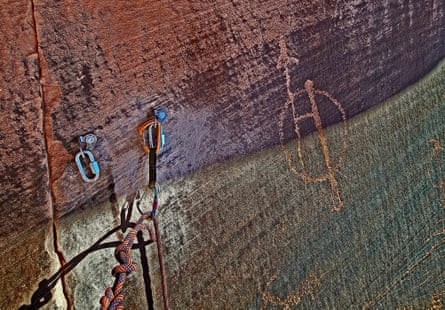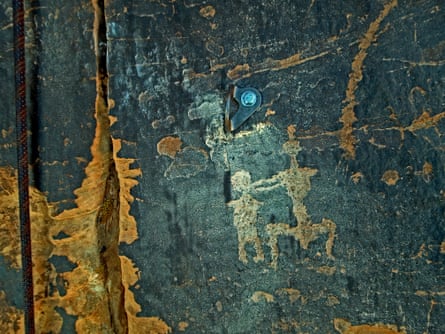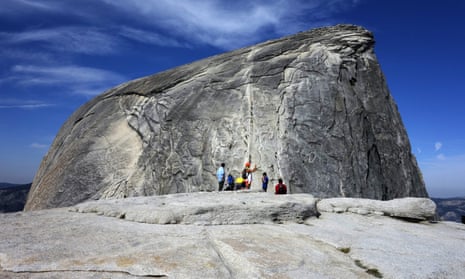Richard Gilbert claims he had no idea he was doing anything wrong when he drilled bolts into a rock wall in Utah to establish three new climbing routes, illegally defacing a 1,000-year-old Indigenous cultural site.
Climbers know the rock Gilbert bolted as Sunshine Wall, a crag north of Moab and Arches national park hosting the centuries-old petroglyphs of the Fremont people. Gilbert has said he didn’t realize the carvings’ significance, even though most climbers make it a point never to disturb Indigenous cultural sites.
Gilbert’s bolts have since been pulled from Sunshine Wall. But his admission last month that he was the one who had desecrated the petroglyphs, in pursuit of sport, sparked a backlash both swift and severe, with scores of news articles on his mistake, disses in outdoors media, even death threats.
“It was horrible to see,” said Skye Kolealani Razon-Olds, executive director of Kanaka Climbers, a Native Hawaiian climbing group, about the bolts. Razon-Olds noted that climbing on petroglyphs had been a problem in Hawaii for more than a decade. The recent news from Utah “hurt me as an Indigenous person”, she added, “knowing how much pain other Indigenous people would feel from seeing that”.
Gilbert’s action revitalized long standing debates about the checkered history of rock climbing, a white- and male-dominated sport whose practitioners have spent decades fighting to climb wherever they please, and often succeeding.

Even as it continues to grow in popularity, there is little recognition that climbing, like much outdoor recreation in the US, depends on land stolen from Native peoples, Native climbers say.
“The United States is unique in the fact that we have so much public land, national parks, national monuments,” said Angelo Baca, a climber and cultural resources coordinator for Utah Diné Bikéyah, a non-profit working to protect Indigenous communities’ lands. “It’s important to understand that it comes at a great price. Dispossession and removal of our Indigenous communities from these places has never been acknowledged or rectified.”
The 2014 documentary Valley Uprising, for example, chronicles the early days of sport climbing in the 1950s and 60s in California’s Yosemite national park, as well as the vagabonds who flocked to its awe-inspiring granite faces. Among the climbers glorified in the film are Yvon Chouinard, founder of Patagonia; Royal Robbins; and Robbins’ rival Warren Harding, whose aggressive climbing style relied on hammering pitons into the bare rock. The park’s lore continues in popular culture thanks to films like Free Solo, the Oscar-winning documentary about Alex Honnold’s ropeless ascent of El Capitan.
None of these films recognize the park’s creation history, including the state-sanctioned Mariposa Battalion’s systematic burning of Native villages and food stores, displacing families from their homes.
Learning history like this, Razon-Olds and Baca said, is the first step non-Native people in the outdoors should take.
“This most recent bolting incident, combined with a history of incidents between the climbing community and tribal nations, only further divides and puts a wedge between the climbing community and tribes,” said Ashleigh Thompson, an anthropology PhD candidate, at a recent panel convened by the Access Fund, one of the nation’s foremost climbing advocacy organizations, that also included Razon-Olds, Baca, the professional climber Chris Schulte and Gilbert, who drilled the bolts in Utah.

Thompson, an Ojibwe woman and rock climber, admitted at the event that she’d been hesitant to appear on the panel, noting the Access Fund’s legal push against a climbing ban on Nevada’s Cave Rock, a sacred site for the Washoe tribe. The fund had claimed that the US Department of Agriculture was promoting the tribe’s religion, even discriminating against climbers.
The fund lost that case and later said the process had helped it learn “the importance of reaching out to and working with Native American tribes whenever possible”.
Today, the fund aims to make space for climbers to listen and learn from Indigeneous people, says its executive director, Chris Winter. He admitted that modern climbing had roots in mountaineering and exploration, and not necessarily sustainability and inclusivity.
“It was about attaining the summit and doing first ascents. I think that’s just been a part of the sport from the beginning and has attracted people who were drawn to that type of sense of accomplishment,” Winter said. “But I think we are becoming more aware of what that means for how we relate to other people and other cultures and the world around us.”
Just last week, another historic petroglyph near Moab, the Ute-era Birthing Scene rock, was found vandalized with violent, racist language. Baca said the act was part of continued brutality against Indigenous people.
Although it is unclear who is responsible, Baca said climbers who wanted to confront this anti-Native violence must consider protecting sacred art as more than just a way to maintain access to their favorite crags.
“If climbers really want to up their game, they have to pick up this not just as good climbing protocol, but as a way to enact restorative and social justice,” said Baca. “Climbers are especially sensitive and aware of the environment and its changes, and because they develop that relationship with the land, they should become guardians and protectors of it too.”
